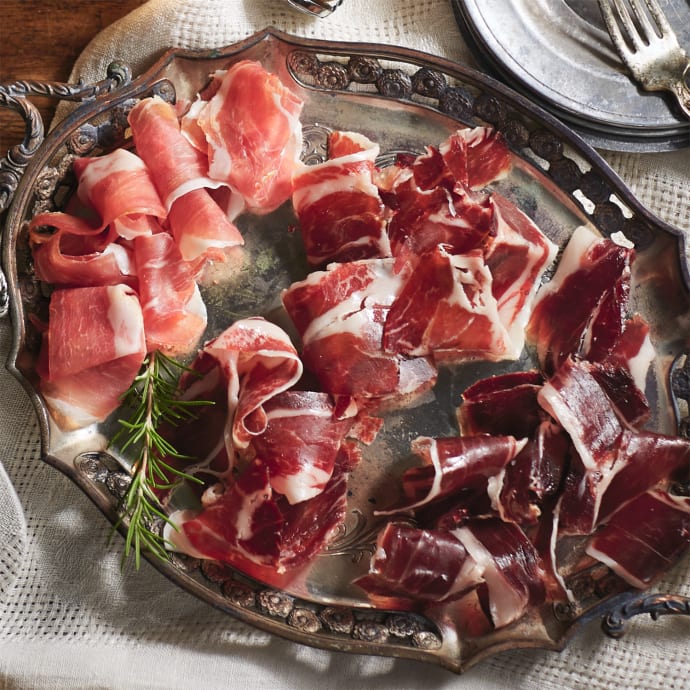Caroline J. Beck
“Just let it melt on your tongue,” Jose Martinez-Valero instructed. “It will dissolve into pure flavor.” I placed the tiniest sliver of jamón Ibérico de bellota in my mouth and waited. The finely marbled fat melted like silk, but the finish was remarkably pure, strangely akin to a classic palate cleanser.
As I positioned myself to snare another sample in the elbow-room frenzy of the Culinary Institute of America’s Worlds of Flavor conference at Napa, California, Martinez-Valero hit me with an even bigger surprise. “This fat is just like the very best olive oil, it’s monounsaturated. It comes from a breed of Spanish pig we call the four-legged olive tree,” he said.
And suddenly I understood why the mouthfeel was so familiar. With years of olive oil tasting under my belt, it was easy to recognize the difference between greasy, mouth-coating fat and this high-quality clean finish.
Jamón Ibérico de bellota is familiar to food cognoscenti as the cured form of this extraordinary animal. At prices north of $1,000 for a single ham, it is not widely available in restaurants or markets. But those who can afford it will go to great lengths to find a reputable source, because it is considered one of the finest foods in the world.
At the heart of its difference is that purebred Ibérico pork represents a very old-world approach to one of the tenets of today’s cuisine: a sustainable, simple focus on pure flavor. But like high-quality extra virgin olive oil, purebred Ibérico pork is under siege from unscrupulous distributors who pass off crossbred meats as purebred, elitist pricing and a disappearing ecosystem (needed to support the swine’s unusual eating habits). The species has been on endangered or at-risk lists for years, a dwindling breed supported by a handful of dedicated producers on a lifelong mission to avoid extinction — of the pig, its pastureland and their very livelihoods.
Martinez-Valero represents Ibérico Fresco, one of few Spanish distributors of 100% purebred, acorn-fed fresh Ibérico meat in the United States. Over the din of pork belly- and backfat-crazed chefs at the CIA‘s annual event, he spoke passionately about the plight of this pig and its unique grazing land, the dehesa (forest) of the Iberian peninsula in Spain.
“It is the very definition of sustainable agriculture. The man takes care of the forest, the forest takes care of the pig, and the pig takes care of the man,” explained Martinez-Valero.
Raising Ibérico pigs is an expensive labor of love
Ibérico pigs are not particularly pretty, galloping along with long legs supporting a chunky body. They are best identified by their distinctive black hooves, hence the Spanish name, pata negra. There are many different breeds of Ibérico pigs, ranging from the productive, big Torbiscal to the delicate Entrepelado, but they all have certain traits in common that strain any producer’s pocketbook. Those include litters half the size of crossbreds, production cycles that are three times as long, and particularly expensive eating habits.
In contrast to the ordeals of pigs jammed into cramped pens and pumped full of antibiotics seen in television news reports on the pork industry, the lives of purebred Ibérico pigs seem like a scene straight out of a fairy tale.
By Spanish law, truly purebred (genetically 100%) Ibérico pigs are required to attain at least 40% of their weight grazing exclusively on holm oak acorns during the montanera, or period of fattening between October and January. Each pig is provided 2 hectares (about 5 acres) of personal space to reach its best weight. The high oleic acid content of the acorns and the genetic makeup of the Ibérico help convert the pig’s fat into its distinctive monounsaturated marbling.
“It’s a marvel, a machine for making healthy meat. It’s perfection,” said Lucia Maesso Corral, president of Aeceriber, the Iberian Pig Breeders Association. She represents purebred producers who are fighting an uphill battle against lesser quality, far less expensive crossbred options that are allowed to take the name “Ibérico.” But their passion for truth-in-labeling and authentic, quality production is palpable.
Without question, the better-known cured ham version is amazing. But one taste of the fresh meat they now call “the other red meat” and you will understand the depth of these producers’ dedication. For a dinner party of two, I sautéed a secreto of carne de cerdo ibérico de bellota (acorn-fed Ibérico pork shoulder skirt) for no more than two minutes per side, classically medium rare with a deep pink in the center, and sliced it like flank steak. Without exaggeration, it may well be the best meat I’ve ever eaten: succulent, sweet, almost nutty. Good enough that we didn’t have the discipline to stop, finishing off the entire cut with no regrets.

 SHIPS FREE
SHIPS FREE SHIPS FREE
SHIPS FREE


 SHIPS FREE
SHIPS FREE SHIPS FREE
SHIPS FREE








